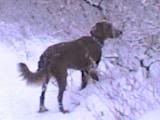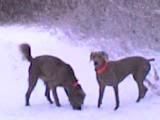Post by smokeybear on Nov 3, 2005 11:55:53 GMT 1
Duck is a commercial food that contains meat, vegetables and grains, the latter is why I will not feed this food to my dogs as they were never designed to consume grains, especially processed, domesticated crops.
Daniela it is not that scientists CANNOT tell you what is in the commercial food it is that it is hardly in the companies interests to be specific; there are labelling laws and the abide by them, if companies want to reveal any more than statutory legislation that is of course up to them.
One of the reasons commercial foods "split" grains is to confuse the uneducated purchaser into thinking that there is more meat than cereal in a product just because the largest SINGLE ingredient is meat and therefore has, by law to be listed first, does NOT equate to meat being the biggest percentage ingredient inside.
EG Lamb, rice, beet pulp, rice bran, rice flour, brewers rice, egg
If you add up all the different forms of rice this recipe should be named rice with a bit of lamb thrown in, rather than what it IS labelled; Lamb and rice!
Consumers are hardly likely to buy a product which says X % protein (but this protein is a) incomplete b) unavailable to your dog c) indigestible d) made up of leather, fur, feather, feet and beaks!
Do you need to know exactly what ratio of ingredients are in each item you feed your children?
No, we know the food groups and what each product contains.
It is the same with dog food.
Look at the bone on wild predators; their parents don't think "hmm, think we need to consume a giraffe today chaps because that will provide the nutrients that are missing in buffalo which we ate last night.
In fact it is easy to find out the protein, calcium, phosphorus etc contents of any raw food, there are plenty of places to look it up.
Bear in mind that in nature there are no "puppy, junior, lite or senior" foods for dogs (just as there are not for humans).
There is no reason to feed a different formula for differing life stages, you just feed more or less of the same thing at the appropriate time.
More health problems were/are caused by people giving for example calcium supplements to puppies and lactating bitches causing bone problems.
We have been brainwashed into believing that only by feeding our dogs food that has been scientifcally produced in a lab can we provide a wholesome, complete form of nutrition for our dogs when people and dogs have been managing for hundreds of years.
It is more appropriate IMHO to remember that the pet food industry was created and thrives due to someone having the idea of making money out of waste food produced for humans and convincing people that they are incompetent in making reasoned and informed decisions for their dogs.
In the wild they would consume small, raw bones Kobie, as they caught, killed and ate their prey animals, rats, mice, rabbits, and bigger animals.
Small raw bones such as chicken are actually quite plastic.
Britbarf is a brilliant source of material on the net and the following books are extremely comprehensive on this subject
The ultimate diet for cats and dogs by Kymythy Schultz source of nutrients and sample diets.
The one by Volhard and there is another one that escapes me at the moment, I can see the front cover by cannot remember its title or author.
I will post when I remember!
Daniela it is not that scientists CANNOT tell you what is in the commercial food it is that it is hardly in the companies interests to be specific; there are labelling laws and the abide by them, if companies want to reveal any more than statutory legislation that is of course up to them.
One of the reasons commercial foods "split" grains is to confuse the uneducated purchaser into thinking that there is more meat than cereal in a product just because the largest SINGLE ingredient is meat and therefore has, by law to be listed first, does NOT equate to meat being the biggest percentage ingredient inside.
EG Lamb, rice, beet pulp, rice bran, rice flour, brewers rice, egg
If you add up all the different forms of rice this recipe should be named rice with a bit of lamb thrown in, rather than what it IS labelled; Lamb and rice!
Consumers are hardly likely to buy a product which says X % protein (but this protein is a) incomplete b) unavailable to your dog c) indigestible d) made up of leather, fur, feather, feet and beaks!
Do you need to know exactly what ratio of ingredients are in each item you feed your children?
No, we know the food groups and what each product contains.
It is the same with dog food.
Look at the bone on wild predators; their parents don't think "hmm, think we need to consume a giraffe today chaps because that will provide the nutrients that are missing in buffalo which we ate last night.
In fact it is easy to find out the protein, calcium, phosphorus etc contents of any raw food, there are plenty of places to look it up.
Bear in mind that in nature there are no "puppy, junior, lite or senior" foods for dogs (just as there are not for humans).
There is no reason to feed a different formula for differing life stages, you just feed more or less of the same thing at the appropriate time.
More health problems were/are caused by people giving for example calcium supplements to puppies and lactating bitches causing bone problems.
We have been brainwashed into believing that only by feeding our dogs food that has been scientifcally produced in a lab can we provide a wholesome, complete form of nutrition for our dogs when people and dogs have been managing for hundreds of years.
It is more appropriate IMHO to remember that the pet food industry was created and thrives due to someone having the idea of making money out of waste food produced for humans and convincing people that they are incompetent in making reasoned and informed decisions for their dogs.
In the wild they would consume small, raw bones Kobie, as they caught, killed and ate their prey animals, rats, mice, rabbits, and bigger animals.
Small raw bones such as chicken are actually quite plastic.
Britbarf is a brilliant source of material on the net and the following books are extremely comprehensive on this subject
The ultimate diet for cats and dogs by Kymythy Schultz source of nutrients and sample diets.
The one by Volhard and there is another one that escapes me at the moment, I can see the front cover by cannot remember its title or author.
I will post when I remember!







